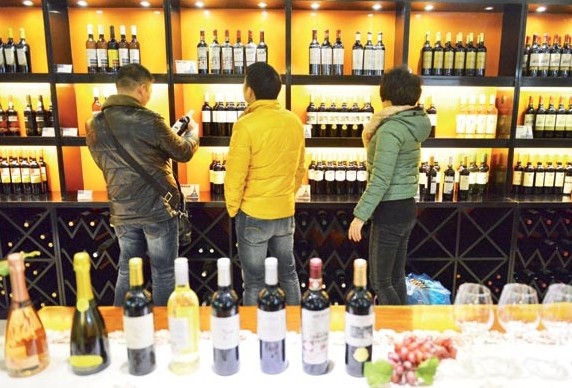

Customers select imported wine at a shopping mall in Yiwu, Zhejiang province. Lu Bin / For China Daily
As domestic winemakers corner more of the market, foreign brands are still fine-tuning their sales strategies
Taking a measured sip of a vintage Bordeaux, Libin Gao swirls the dark liquid in his mouth, pausing to reflect before scratching down a few notes on the form beside him.
It's a Saturday afternoon in Beijing and class is in session. For Gao and the 12 other students occupying Dragon-Phoenix Wine Consulting's packed 8th floor classroom it's a chance to make Chinese wine history.
Gao, a member of the pilot program that teaches Level-three Wine Spirit Education Trust Certification in Mandarin, will, on successful completion of the course, become one of the highest-ranked wine experts in China.
As regional manager for Joyvio, Lenovo's food and agriculture venture, Gao knows that getting an international certification would give him an upper hand in one of China's most lucrative industries.
"In the Chinese market right now, much of the focus is on the packaging of wine. I want to be a part of the movement that will shift the focus from packaging to what's actually in the bottle," Gao says, during a five-minute breather from the eight-hour class.
For Gao, the course is a chance to gain a competitive edge. But for wine producers, changing the way Chinese perceive and drink wine is a necessity for an industry that is undergoing tumultuous change.
Spending power
In the past five years China has had a ravenous thirst for wine, fueled by the middle class flexing their spending power and a shift in drinking habits from beer and baijiu (white spirits) to purportedly more healthy red wines.
Sales of imported wine grew from $1.29 billion in 2008 to $5.49 billion last year, experiencing annual growth rates as high as 50 percent, according to a report published by Vinexpo, a leading French wine fair operator.
In 2013, China was the largest market of red wines globally, overtaking France and Italy where the quantity imbibed has been falling. Chinese people drank more than 1.86 billion bottles last year, the report said.
However, during the past five years, wine sales have also polarized in China, with purchases of either high-end or low-price wines dominating sales figures, says Edward Ragg, co-founder of Dragon Phoenix Wine Consulting, a leading independent wine consulting company in China. "Traditionally, there hasn't been a real market for middle-priced wines," he says.
Ragg, who helped found Dragon Phoenix Wine Consulting in 2007, has been assisting foreign wine producers and educating drinkers in China.
"China was, and still is for the most part, a market where sellers can name their price," he says.
"If you, as a wine importer, were more likely to sell a 100 yuan ($16) bottle for 200 yuan, and the buyer was more eager to buy the more expensive product, why wouldn't you?"
He says while the past five years have seen a boom in wine sales, growth is slowing as bulk purchases by State and corporate clients dry up, with producers emphasizing more high-quality, low-priced wines.
"There are a lot of people who got on the bandwagon selling wine during the early boom years and they're realizing that China is not the massive wine market in the way people think it is," Ragg says.
Recent austerity measures to curb gift-giving and spending at official banquets have shrunk large orders of fine wines, with sales growth slowing from 18 percent in 2012 to just over 5 percent in 2013.
With an overabundance of upmarket wines and distributors eager to find buyers, sales of top-end wines in China have hit a plateau, with prices of some of the most expensive brands dropping, in some cases by more than 50 percent.
In 2013, the price of a 2008 Lafite wine tumbled 53.4 percent to 7,230 yuan ($1,180), and the price of a 2004 Lafite wine fell to 2,850 yuan from 4,900 yuan.
The shift has seen dozens of distributors, who once catered solely to the fine wine market, go bankrupt, with stocks of high-priced wines remaining buried in warehouses.
"The top end of the market has pretty much become flat," says Nikki Palun from De Bortoli Wines, Australia's fifth-largest exporter of wine.
"Most of the businesses that focused on the government and corporate channels have gone bankrupt or are saddled with excess inventories."
She says as a result, many producers have had to promote sales of entry-level, lower-price wines.
"To stay afloat in the wine industry in China, you have to target those people who are using their own money to buy wine. As a result the prices have dropped."
China's wine drinkers have traditionally stuck to domestic brands. More than 80 percent of the wines drunk in China are domestically produced, with imports hovering between 15 and 20 percent in the past five years.
The biggest advantage Chinese vineyards have is in understanding how to effectively establish operations and market to Chinese clients, says Judy Leissner, owner of Grace Vineyard, the only family-owned boutique winery in China.
"An obvious advantage that a domestic producer has is the understanding of the local market. This is something that foreign producers can expect to gain only over years," she says.
"Domestic producers also understand better how to operate in China, for example how to set up a winery, which department to deal with, how to deal with the growers and government, and what incentives are available."
Copyright ©1999-2018
Chinanews.com. All rights reserved.
Reproduction in whole or in part without permission is prohibited.